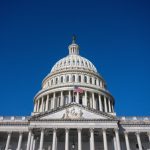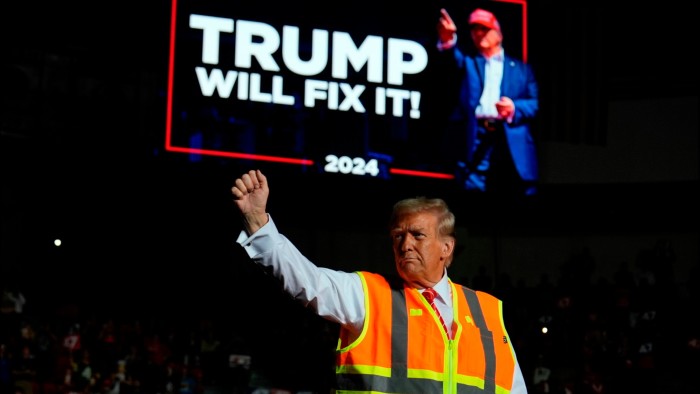It’s been nearly two weeks but it feels to me like six months. There’s now feverish briefing about Donald Trump’s picks for his economics and trade team. It’s hard to imagine them being quite as eccentric as for defence and national security — unless he appoints as Federal Reserve chair a crypto fundamentalist who rejects fiat currencies on principle and a survivalist Treasury secretary who believes in a barter economy. Let’s not rule anything out.
While we’re waiting, today’s newsletter asks which of his various plans would be easiest to get done regardless of the personnel doing them. Charted Waters is on the US’s reliance on foreign-born workers. Thoughts, questions, whatever: email me at alan.beattie@ft.com.
The lines of least resistance
The palace politics of Trump’s trade and economics team are enveloping us. Which of the hordes of soi-disant “close Trump advisers” will be appointed, will they have his ear, will they get confirmed by Congress and so on. I don’t think you can read straight across from appointments to policies though. As previously noted, trade policy in his first administration emerged from fierce internal battles like a victorious but bloodied rat crawling out of a sack of rodent corpses, with Trump’s caprice determining which idea survived. It will be the same again this time, I think, only with Elon Musk as a particularly rogue rogue player.
For the moment, rather than Beltway Kremlinology, let’s just rate the feasibility of Trump’s various ideas by thinking about where the lines of least constitutional and political resistance are. (Obviously if Trump actually suspends the US constitution and rules by decree we’re in a somewhat different game.)
Tariffs
There are three main ideas here: a 10 or 20 per cent blanket tariff on all trading partners and a 60 per cent tariff on China, a “Reciprocal Trade Act” where tariffs are set equal to those of trading partners, and possible formal preferential trade agreements. Note all of these are colossal abrogations of WTO obligations, but I’m assuming that doesn’t matter to Trump at all.
10-20% tariffs in general and 60% on China
Rating: Easy
Trump has various powers he can use (Section 232 national security tariffs, Section 301 corrective tariffs, the International Emergency Economic Powers Act) to impose unilateral duties if he feels like it. Congress or the Supreme Court could try kicking up a fuss if they so wanted. They will not do so.
The use of unilateral tariffs will also make it relatively easy to grant exceptions for domestic companies wanting to import and for trading partners offering him something in return for the tariffs being lifted. “Something” here could, of course, involve personal favours on a massive scale.
Reciprocal Trade Act
Rating: Moderate to hard (depending on how comprehensive Trump wanted it)
The RTA would match each trading partner’s tariffs with US ones. As its name suggests, Trump seems to want this to be an actual act of Congress rather than just making it up as he goes along with unilateral tariffs. It harks back to the Reciprocal Trade Agreements Act of 1934, which (ironically) allowed Franklin Roosevelt to negotiate down the high Smoot-Hawley tariffs imposed in 1930.
The RTA would still be a total violation of WTO most-favoured-nation status and would involve gigantic amounts of technical work if he were to do it on all imports from all trading partners. But he would be very unlikely to get that through Congress: as I’ve noted before, it would open up some rather sensitive bits of US agriculture, such as cane sugar and dairy, to some nasty competition. Selecting particular products and partners — in fact, using unilateral tariffs to force reciprocal change — would be considerably easier.
Preferential trade agreements (PTAs)
Rating: Moderate
A formal bilateral or regional agreement needs Congress to grant Trade Promotion Authority and pass the final deal. That takes time and means giving the lobbyists a better chance to get at it. How high the congressional hurdle is would depend on who the partner is and what the details are.
Transforming the existing deal with Canada and Mexico from Nafta to USMCA during Trump’s first term was quite doable. A brand new agreement with the EU or even the UK would be trickier, prompting resistance from the trading partner after our old pal the US farm lobby started demanding changes in regulations. While Trump might well be prepared for American farmers to get shafted by retaliation to his unilateral tariffs, getting deals past the agriculture committees on the Hill is a different matter.
Currencies
Weaken the dollar
Rating: Hard
(Thanks to George Pearkes, global macro strategist at the Bespoke Investment Group for thoughts here.) The Treasury has control of foreign exchange policy, so in theory could sell dollars to drive the exchange rate down, though it would be a fairly extreme move. It might also not work, since the Fed could respond by raising interest rates. As a general proposition, intervention only tends to work if it’s unsterilised (that is, the central bank doesn’t take away what the finance ministry has given).
Trump could try bullying the Fed to hold down rates and accommodate the intervention, but assuming it holds firm there’s not much he can do. Only two of the Fed’s governor positions come vacant over the next four years, giving him limited opportunity to remake it in his image. The chair position will also open up, and Trump could appoint someone loyal to him, but there’s no reason the other governors have to do what the chair says. The dominance of the Fed chair over the central bank’s strategy rather depends on them being somewhat sensible and prepared to listen to others.
Charted waters
I didn’t mention Trump’s plans on immigration above, which will obviously make a huge difference to the economy. The rising share of foreign-born workers in the US workforce suggests that a major anti-immigration policy would be a serious shock.
Trade links
-
Xi Jinping is preparing to score another geopolitical open goal by dressing himself up as the champion of open multilateral trade, just as he did last time Trump was president.
-
Trade Secrets favourites Agathe Demarais and Abraham Newman write in Foreign Affairs that the EU needs a new strategy against economic coercion.
-
Along with esteemed FT colleagues Andy Bounds in Brussels and Brooke Masters in New York, I did an online Q&A last week on everything to do with Trump, trade and markets. There were one or two particularly interesting questions I hadn’t thought of before.
-
On the question (which I also put to readers) of what trading partners can do to shield themselves from Trump, see these pieces by the FT’s Soumaya Keynes and Flint Global’s Sam Lowe writing for Alphaville.
-
From a few months ago, this piece by political risk expert Rachel Ziemba, about how countries have managed to dodge tariffs and sanctions on booze in the past, is interesting in the light of China imposing anti-dumping duties on EU brandy. (It’s also very entertaining.)
Trade Secrets is edited by Harvey Nriapia
Read the full article here













